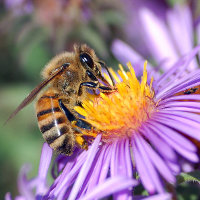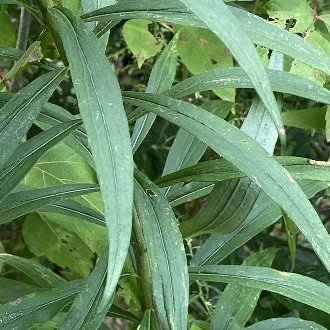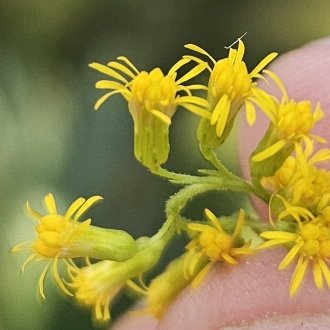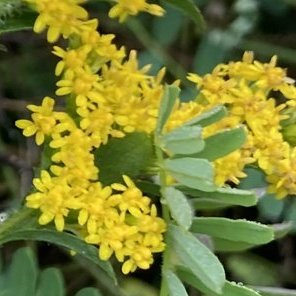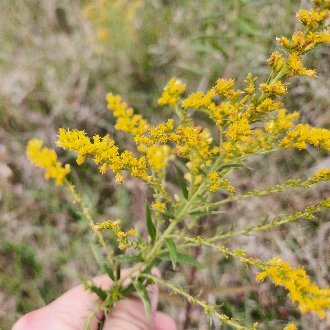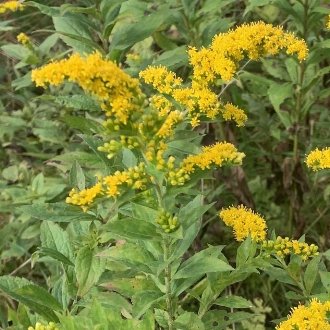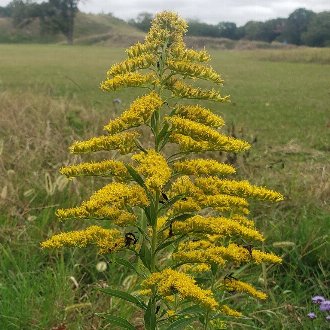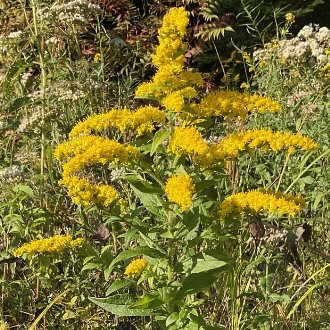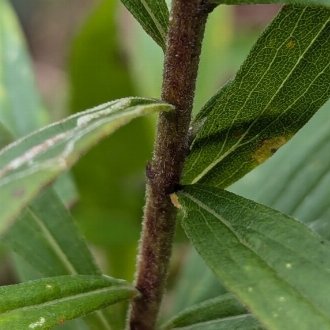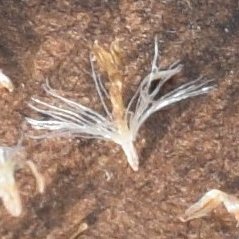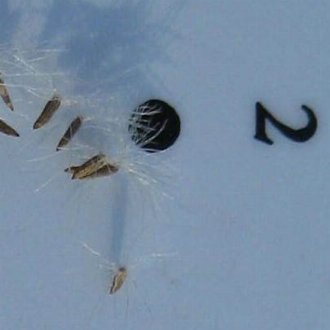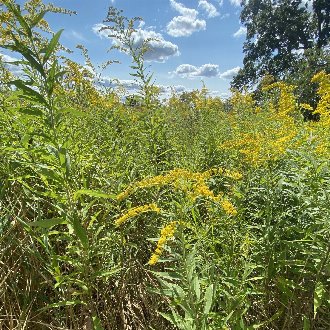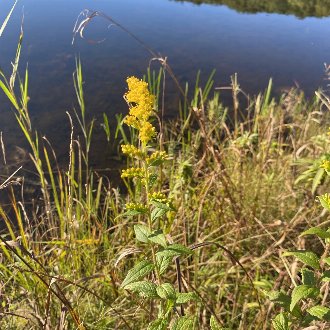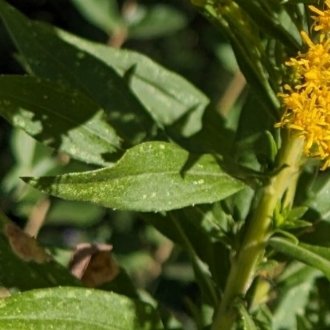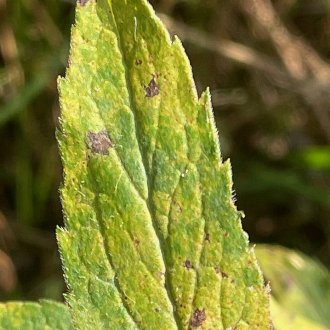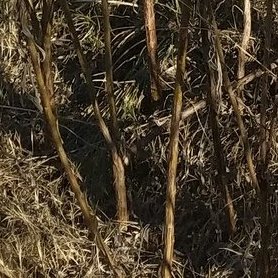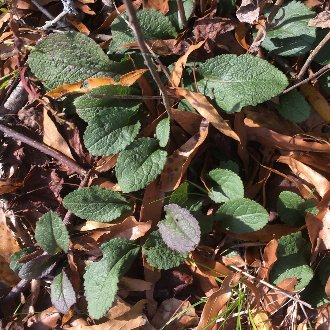Tall Goldenrod vs Wrinkleleaf Goldenrod
This guide is under construction and has not been published yet. It may have errors. When in doubt, double-check other sources for definitive ID.These two species have a wide range of overlap and are frequently confused. Both are common, tend to form large colonies, grow to similar heights, and have highly variable inflorescence sizes and shapes. They are easily told apart by leaves, or rays of the flowerheads, and they have many other differences. S. altissima ranges farther south, west, and northwest, and prefers drier, better-drained sites, whereas S. rugosa ranges farther northeast and prefers moister sites and acidic soils and is slightly more shade-tolerant.
Tall Goldenrod (Solidago altissima) | Wrinkleleaf Goldenrod (Solidago rugosa) |
A common, aggressive perennial of rich, sunny, disturbed sites, native to a wide range across North America. | A perennial of moist, sunny sites with slightly acidic soil, common across a wide range in eastern North America. |
Lower leaves average longer (95-150mm) and narrower (16-20mm) and have a triple-veined look, with two prominent side-veins running most of the length of each leaf. Leaves look relatively flat or untextured other than the three main veins. Photo © Sandy Wolkenberg, CC BY 4.0. | Lower leaves average shorter (68-104mm) and wider (20–25mm) and usually have a strongly-textured appearance to veins, often leading the leaves to look wrinkly. Leaves have many side-veins, with no side veins particularly prominent relative to the others. Photo © Alan Prather, CC BY 4.0. |
Flowerheads have more (8-13) ray florets, and the rays are much narrower (0.1–0.4mm) and much longer than wide. Rays look flimsy and tend to droop more. Photo © Daniel McClosky, CC BY 4.0. | Flowerheads have fewer (6-8) ray florets, and the rays are much wider (0.4–0.7 mm) and shorter relative to their width. Rays look robust and tend to droop less. Photo © Jaime McGuigan, CC BY 4.0. |
Inflorescences of some plants may have ascending branches that do not appreciably droop or curve back. Photo © Dominic, CC BY 4.0. | Large ascending branches of an inflorescence almost always curve back at least slightly. Photo © scaup, CC BY 4.0. |
Inflorescence branches tend to be spaced closer together, leaving less space when viewing the inflorescence from the side. Each branch looks thinner or less bushy. Photo © Jody Shugart, CC BY 4.0. | Inflorescence branches tend to be spaced more widely apart, leaving more space when viewed from the side. Each branch often looks bushier or thicker. Photo © Ethan Beaudet, CC BY 4.0. |
Stem, higher up on the plant, is consistently covered in short hairs, with relatively little variation. Photo © Skyler Principe, CC BY 4.0. | Stem pubescence is more variable, ranging from none on var. sphagnophila, to dense. Some individuals of var. rugosa may look similar to S. altissima, but most other varieties with hairs have longer hairs. Photo © Bill Keim, CC BY 4.0. |
Pappi (wispy parts attached to seeds) are longer (2.5–3.5mm) Photo © Alex Zorach, CC BY-SA 4.0. | Pappi are shorter (1.8-2.5mm) (dot is 2 mm in diameter for reference) Photo © rboles, CC BY 4.0. |
Prefers drier habitats and more neutral to slightly alkaline soil (pH > 6.5) although flexible on both points. More demanding of sun. Photo © botany08, CC BY 4.0. | Prefers moist habitats and acidic soil (pH < 6.0) although flexible on both points. Tolerates slightly more shade. Photo © Bonnie Semmling, CC BY 4.0. |
Serrations on leaf margins are less pronounced; leaves higher up on the stem may lack serrations entirely, or have only subtle serrations. Photo © ncb1221, CC BY 4.0. | Leaf margins average more coarsely serrated. Serrations become finer higher up on the stem, but leaves under the inflorescence, and even in the inflorescence, usually still have pronounced serrations. Photo © Tom Scavo, CC BY 4.0. |
Plants lack basal leaves during the growing season. Photo © Leila Dasher, CC BY 4.0. | Plants have basal leaves, which usually wilt well before flowering, but new basal leaves emerge around or after flowering, and persist through winter. Photo © Becky Dill, Public Domain. |
Additional Notes
Both of these species are abundant, highly variable, and have multiple sub-taxa. Nonetheless there are so many differences between the two that they are usually easy to tell apart. On average, S. rugosa blooms slightly earlier than S. altissima, usually by about two weeks, but both species have such long bloom periods, and the period of overlap between the two of them is so great that in most cases bloom time is not useful for ID.The broader leaves of S. rugosa likely reflect its slightly greater shade-tolerance as well as propensity to grow in moist habitats; it is subjected to less drought stress and thus benefits from greater leaf surface area, which allows it to thrive in slightly shadier conditions even if it prefers sun, whereas S. altissima grows in drier conditions, and thus needs reduced leaf surface area to protect from drought, but this makes it less able to cope with low-light conditions.
The range of S. rugosa, which extends much farther northeast than northwest, may be related to its basal foliage, which would be killed in the harsh winters of places like Minnesota and Wisconsin, but are able to survive in the slightly-more-mild winters of Michigan, New England, and southeastern Canada. S. rugosa extends around the southern shore of Lake Michigan but becomes conspicuously absent on its western shore, and similarly, is absent from the westernmost portion of Michigan's upper peninsula, similarly exposed to greater cold. The basal foliage may also relate to soil pH preferences, as habitats with acidic soils often have slightly less ground-level competition than the near-neutral habitats favored by S. altissima; steep competition at the ground level from other plants would render the basal leaves less useful.
S. altissima is more frequently confused with canada goldenrod (Solidago canadensis) or giant goldenrod (Solidago gigantea), and S. rugosa can be confused with either. S. rugosa on the other hand is more frequently confused with elmleaf goldenrod (Solidago ulmifolia).
References & External Resources
These short lists show only links helpful for ID. For a complete list of references and resources also covering other aspects of ecology, visit the links section of the full article on each plant, which is the first entry here.

